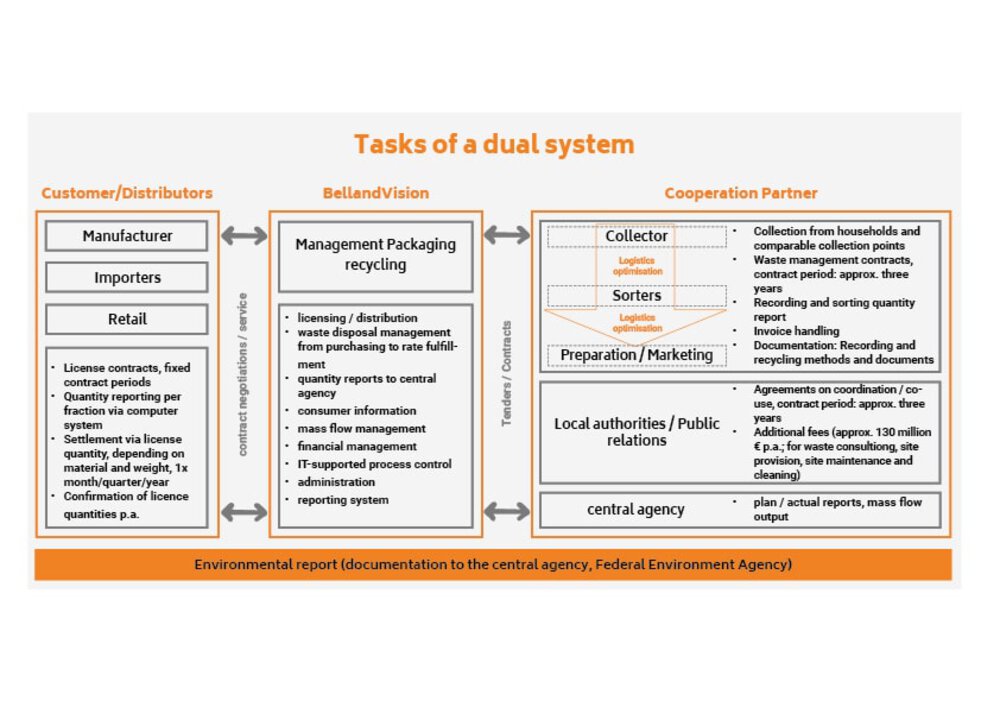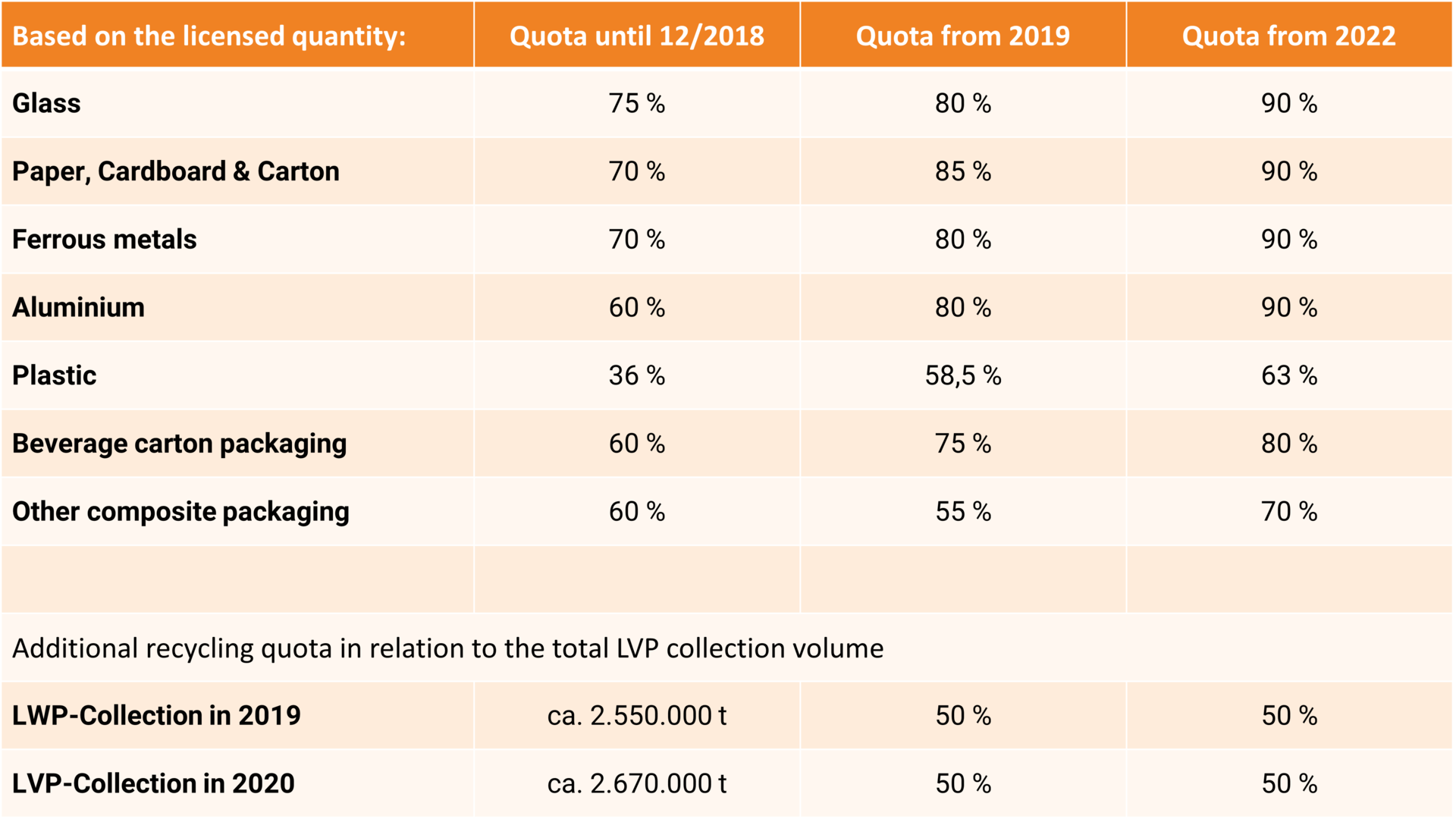
The dual system: Any questions? No problem!
Here are your answers
All the answers to the most frequently asked questions, e.g. what a dual system is, why your packaging has to be licensed and what else distributors have to consider, can be found here. The dual system introduces itself!
Who are the dual systems and what are their tasks?
Every company that (for the first time) commercially markets packaging that is subject to system participation must take it back free of charge after use and recycle it by participating in the dual system. In practice, the take-back and disposal or recycling of used packaging is then taken over by the dual systems.
On behalf of industry and trade, the task of a dual system is to organise the nationwide collection, sorting and recovery of used packaging subject to system participation and to document the fulfilment of the recycling targets in accordance with the law. The background to this is the product responsibility of manufacturers and distributors for their packaging anchored in the Packaging Act and the resulting regulation of comprehensive take-back, recovery and deposit obligations.

Which packaging must be participated in a system?
Not all packaging is the same. However, all packaging that typically accumulates as waste after use by private end consumers or comparable sources must participate in a dual system. This includes the following types of packaging:
▶ Sales packaging is typically offered as a sales unit consisting of goods and packaging and serves to protect goods during sale and to hand them over safely to consumers (e.g. shampoo bottles, tins, etc.). They also contain all the important information about contents and - depending on the design - are intended to encourage consumers to buy. Since this packaging typically accumulates as waste in private households, they must be participated in a dual system.
▶ According to the definition, secondary packagings are packagings that contain a certain number of sales units and are typically offered to the end consumer together with the sales units or serve to stock the sales shelves (e.g. shrink film for bundling mineral water bottles or small beverage cartons).
▶ Service packaging is packaging that is only filled at the point of sale - i.e. it is used to hand over goods (e.g. bread bags, bags for fruit and vegetables, pizza boxes, coffee-to-go cups, take-away boxes). In principle, the retailer, baker, butcher or snack bar operator who purchases the empty packaging and keeps it in stock for filling is obliged to participate in the system under a licence. However, service packaging is the only type of packaging that can be purchased "pre-licensed". In the case of pre-licensed service packaging, the "filler" may require his pre-supplier to prove to him that he has already licensed the packaging.
▶ Shipment packaging is packaging that is only filled at the final distributor in order to enable or support the shipment of goods to the end consumer (e.g. cardboard boxes in which online mail order companies ship goods to end customers). Shipment packaging is explicitly considered sales packaging and is therefore subject to system participation, if it typically accumulates as waste at the private end consumer.
You are still not sure whether your packaging is subject to participation? Then the quick check of the Central Agency can give you assistance.
Does the participation obligation apply to all sales packaging?
Exceptions confirm the rule. Exempted from the obligation to participate are sales packaging…
▶ for certain pollutant-containing filling goods,
▶ whose participation has been prohibited due to system incompatibility,
▶ which arise in the commercial sector (e.g. production waste),
▶ that are exported and therefore do not accumulate as waste in German householdsGermany to end consumers
▶ as well as one-way drinks packaging subject to a deposit and
▶ reusable packaging.
If goods are shipped in used packaging, do they also have to be participated in a system?
Yes. An exception applies only if this packaging has already been demonstrably licensed to participate in a system.
What do the collection systems of the dual systems look like?
Packaging can only be recycled if end consumers collect their used packaging separately from residual waste. For this purpose, German private households have the "free" disposal options of the paper bin, the yellow bag / the yellow bin as well as public containers for used glass.
What happens to the packaging after it has been disposed of by private end consumers?
Valuable raw materials are needed for the production of packaging: Plastic packaging is mostly made of crude oil; cardboard boxes are made of wood fibres; container glass is made of quartz sand. In order to use these resources as often as possible and thus protect our environment, the Packaging Act in Germany specifies recycling quotas for different materials. It is the task of the dual systems to collect used packaging from private end consumers at home, sort it and then recycle it in the best possible way. The overriding goal is to close material loops so that no new resources are used for the production of packaging or products.
We have summarised detailed information on the recycling of glass, paper, plastics and metals for you here: Info on closed recycling loops
What are the environmental objectives of the Packaging Act?
Section 16 (2) of the Packaging Act specifies the following recovery requirements (average/year) - also referred to as recycling quotas - for packaging subject to system participation:

Regardless of the fraction-specific recycling targets, an additional 50 % of the total collection volume of light weight packaging (LWP) in yellow sacks/yellow bins, including waste and misdirected waste, must be recycled so that, in the best case, new packaging can be created from used packaging.
The already high and increasing proportion of residual waste in the yellow sacks and yellow bins generally impairs the recycling of the fractions, but in particular makes it more difficult to achieve the 50% recycling quota for the entire collection volume of LWP. In addition, due to the municipalities' scope for decision-making on the type of collection containers significantly more yellow bins are used and yellow sacks are substituted, with all the disadvantages of increasing littering. Furthermore, it has to be noted that with the introduction of the polluter-pays or weight-dependent residual waste billing (the so-called Ident system), the containers for packaging disposal will increasingly be misused for residual waste disposal and thus the "50 % quota" will be severely jeopardised.
How does the system participation obligation work?
Manufacturers, traders (online and stationary) and importers who place goods on the market in Germany for the first time on a commercial basis and whose packaging simultaneously accumulates as waste at the private end consumer must conclude a contract with a dual system in addition to registering with the Central Body. In this contract, they indicate, among other things, the quantities of packaging they expect to place on the market in the year for which the participation contract is concluded. The quantity per fraction actually placed on the market must be reported to the dual system on a monthly, quarterly or annual basis. For these quantities, the dual system costs (participation fees) for collection from private final consumers, sorting and recycling must be paid. If all these requirements are fulfilled, the packaging participates in a dual system.
How are the dual systems financed?
In Germany, the so-called first distributors of packaging subject to participation in the system are legally obliged to bear the costs for the disposal and recycling of their packaging waste. To this end, the companies must participate in a dual system by paying a licence fee and a participation fee. The dual systems use this fee to finance the nationwide collection, sorting and recycling of used packaging.
What is the purpose of these obligations under the Packaging Act?
The aim of the legal requirements through the Packaging Act is to continuously improve the recycling of packaging in Germany, thus saving valuable raw materials and reducing the emission of climate-damaging CO2 gases. The legislator therefore obliges the distributors of packaging to license their packaging (placed on the German market) and thus to bear the costs for the collection, sorting and recycling of the waste.
With regard to recycling, the Packaging Act specifies so-called recycling quotas for the different packaging materials. This encourages both the dual systems and the manufacturers to jointly optimise packaging recycling. From 2025, the Packaging Act also stipulates the reuse of recycled materials. Thus, from 1 January 2025, PET one-way plastic beverage bottles must consist of at least 25 percent by mass of recycled materials. The obligation to use recycled material in one-way plastic beverage bottles will be extended from 2030 to the effect that they must consist of at least 30 percent by mass of recycled material, regardless of the plastic.
However, this system participation obligation for manufacturers, traders and importers is not new. Even under the Packaging Ordinance in force before 2019, packaging that accumulates as waste at private end consumers had to participate in the dual system. The only difference is that the Packaging Act created the Central Body as a control authority that monitors the activities of all market players in detail and with which every manufacturer must register in addition to system participation.
How can you fulfill your obligations under the Packaging Act conveniently and cost-effectively?
Participation in the dual system BellandDual works in three simple steps:
1. You register online with the Central Packaging Register (LUCID). Please note that from 1 July 2022, all manufacturers who place packaged goods on the market in Germany - irrespective of whether the packaging rejects are generated as waste by private end consumers - must register with the Central Body.
2. You participate your packaging in the dual system BellandDual. To do this, you can easily use our online licence calculator: With just a few clicks, you can first determine your licence costs without any obligation - with the option for the ensuing licensing of your packaging.
3. You must report the quantities of packaging actually placed on the market by you in the previous calendar year to us as well as to the Central Office on an annual, quarterly or monthly basis. We will be happy to assist you with any questions you may have on the reporting of data quantities. If you exceed certain de minimis limits, you must also submit a declaration of completeness to the Central Body that has been verified by a neutral expert.
When do you have to license your packaging?
First-time distributors must license their packaging before it is placed on the market. There is no lower limit: anyone who puts packaging into circulation must participate it in a dual system from "the first gram" or from the first packaging. Use the quick check of the Central Office to find out quickly and easily whether your packaging is subject to system participation.
Is there a de minimis limit (lower limit) to the licensing obligation?
No, any packaging that is commercially placed on the market and that typically accumulates as waste in private households must be licensed. This means that every distributor must participate his packaging from the "first gram" or from the first packaging in the dual system. There is only a de minimis limit for the obligation to deposit the declaration of completeness.
How much does packaging licensing cost?
The amount of the participation fee depends on the packaging quantity and the packaging material. With our online licence calculator, you can calculate your licence costs easily and without obligation - and, if required, complete the licensing process with just a few clicks: To the licence calculator
How do I group my packaging into the correct material types according to VerpackG?
The correct material types of packaging subject to system participation are important, because different recycling quotas must be achieved for the different packaging materials. If you report your packaging quantities in the wrong type, they are considered as not participated. Therefore, all producers (first-time distributors) are legally obliged to properly report the quantities per material to their dual system and the central body.
In order to avoid possible sanctions for incorrect system participation, we have prepared an information sheet for your assistance.
How do you determine the weight of packaging to be licensed according to the Packaging Act?
The following 4 steps are necessary to determine the packaging weight:
Step 1: Classification of packaging as subject to system participation pursuant to the Packaging Act (§ 3 VerpackG). According to the Packaging Act, all sales packaging and secondary packaging that typically accumulates as waste at the private end consumer or comparable sources of waste generation must be participated in a dual system. By answering a few questions you can find out, whether your packaging is subject to system participation: To the quick check
Step 2: Empty out residues of the packaging. If no packaging blanks are available for weighing, the filled packaging must be emptied of residues by squeezing, emptying or rinsing.
Step 3: Disassembly and allocation of the individual packaging components. In order to be able to allocate the packaging components to the corresponding material fractions, the packaging must be broken down into the individual packaging components. In this context, the following rule of thumb applies: If the individual components can be separated manually, it is possible to assign them to the individual material fractions. If this is not the case, it is a composite. It can be checked again using the 95/5 rule. If individual packaging components have a weight share of <5 %, they must be assigned to the main fraction (e.g. the label of a glass bottle). If this is not the case, they must be treated like main types of material and allocated individually to the corresponding material types. For assistance, please consult our leaflet on the correct classification of packaging subject to system participation.
Step 4: Determine the weight of the individual packaging components. Once you have broken down the packaging into the individual components and assigned them to the correct material type, the individual components must be weighed and multiplied by the number of units sold. Our guide to packaging weighing is available for this purpose: Info on packaging weighing
When is the retailer (private label) and when is the producer (industrial label) required to participate in the system for a brand?
The decisive factor is the manufacturer's information on the packaging. If a package is...
...labelled exclusively with the name and brand of the producer/filler, then it is a so-called "industrial brand" and the producer/filler is a distributor subject to system participation.
...marked with the trade mark belonging to the trade and the name of the producer/filler, then it is a so-called "non-genuine private label" and the producer/filler is a distributor subject to system participation.
...labelled exclusively with the trade mark belonging to the trade and/or the name of the trade, it is a so-called "own brand" and the trade is a distributor subject to system participation.
You are still not sure whether your packaging is subject to system participation? With the quick check of the Central Packaging Register Office you can find out quickly and easily by just answering a few questions.
Does packaging/packaged products that are exported abroad have to be licensed in Germany?
No. All packaging that can be proven to be exported does not have to participate in a dual system in Germany because it is not generated as waste in Germany.
Are packaging/packaged products imported into Germany subject to licensing?
Yes, imported packaging or packaged products that accumulate at the end consumer or comparable sources of waste generation must be participated in a dual system in Germany.
In the case of imports, the decisive factor is who imports the packaging into the scope of the Packaging Act, i.e. who is responsible for the goods at the time they cross the border and is therefore considered to be a manufacturer subject to system participation. In practice, two cases are mainly relevant, which we would like to briefly present to you in the following. Responsible for the border crossing is:
▶ The producer/exporter located abroad (free delivery): In this case, the producer/exporter located abroad is considered the manufacturer and is liable to participate in the system.
▶ The importer who purchases goods abroad (purchase ex works): In this case, the importer (this can also be the trade or a distribution company of the producer located abroad) is considered the manufacturer and is liable to participate in the system.
Further information on the obligations according to the Packaging Act can be found in the info for importers.
What applies to online traders?
Online traders must note that in addition to sales packaging, shipping packaging (incl. filling material) is also subject to system participation. An online trader is therefore considered to be a manufacturer subject to system participation according to § 7 VerpackG at the latest if he sends online traders goods with shipping packaging (e.g. in a shipping box or shipping bag) to private end consumers in Germany.
An exception is when online traders use a dropshipping service provider and thus have no physical contact with the goods: In this case, the e-commerce trader only has to license the packaging if it is exclusively named in the manufacturer's details. If the manufacturer's details also contain the name of the dropshipping service provider, it is also responsible for licensing the packaging.
Everything you need to know about system participation for online traders can be found here: Dual system - Info for online retailers